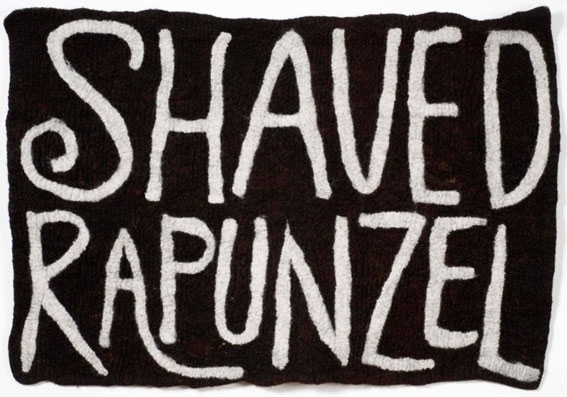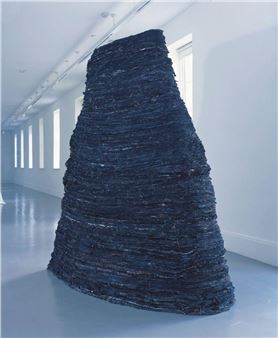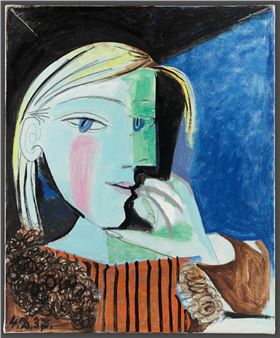Orla Barry: Nought Ytaught to Speke by Crafte Nouper by Kynde
Originally made as part of the stage set in the last scene for the performance work MOUNTAIN 1, Orla BarryвҖҷs Shearling Felts, epitomize her central artistic concern of вҖңphysicalising languageвҖқ 2. Indicatively employing video, performance and sculptural materials, BarryвҖҷs work in general rotates arrangements of words in time and space вҖ” arguably what Kristeva 3 described as intertextuality вҖ” to mine exploratory seams of purpose, through direction, rhythm and form, underpinning, undermining, extenuating and/or at times, exterminating meaning. Pristine structuralist categories of language break down under the pressure of the other side of language; the irreverent, the mocking, satirical or carnivalesque, a context in which Kristeva insists upon the importance of the вҖҳspeaking subjectвҖҷ as the principal object for linguistic analysis.
вҖңTo investigate the status of the вҖҳwordвҖҷ is to study its articulations with the others in the sentence and then to look for the same functions or relationships at the artiticulatory level of larger sequences. Confronted with this spatial conception of languageвҖҷs poetic operation, we must first define the three dimensions of textual space where various semic sets and poetic sequences function. These three dimensions or coordinates of dialogue are writing, subject, addressee and exterior text. The wordвҖҷs status is thus defined horizontally as well as vertically.вҖқ4
Orla BarryвҖҷs felts speak vertically and horizontally, as both subject and addressee. The felted words вҖ“ soft, present, off-whites set against deep, recessive, chocolate space - function as both image/object against ground and inverted words to the page (negative reversals). In both the first and third person, acting as descriptions and commands; вҖңSpit indigo and violetвҖқ, they create an urgency and immediacy of the other side of language that is palpable in its physical proximity, yet dense and occluded in its elusive commentary 5. Again in her own words, the Shearling Felts were eventually considered вҖңtoo porousвҖқ for the set of MOUNTAIN and were edited from the work, with an abstract future desire for greater space and isolation, to both contain and resonate their presence and multi-directional meanings. Separated by approximately a kilometer from the venue of the restaged performance at Project 6, their moment has come, free to vent their loving anger in an isolated resonance chamber.
On an intertwined personal level, crucial to the reading of the felt works, Barry has recently returned to her native Ireland after years of living and working productively in Belgium, and now divides her time between artmaking, teaching and (unexpectedly) working as a shepherd. Her studio in rural Wexford looks out onto meadows populated by pure-breed Zwartbles sheep 7, whose wool (as well as individual names; Marilyn, Patsy, Iris, Ivy etc., and by inference their particularized personalities) have become the physical and psychological materials of the Shearling Felts. After each sheep was shorn, the fleeces are washed, dried, carded and felted by hand. This ancient, arduous and essentially seasonal process (none of which escapes the artist) involves rolling and beating the raw wool in different directions and combining it with grease or soap and varying degrees of hot water to produce the final, dense, protective (or as a Beuysian reference would suggest; lifesaving) material.
BarryвҖҷs title for the privileged exposition of the felts refers to John De Trevisa's Middle English translation of Bartholomaeus Anglicus, De proprietatibus rerum (On the Properties of Things) 8. Written sometime around 1240, AnglicusвҖҷ text is an early precursor of the encyclopedia, wherein when speaking of fauns 'crafte' is semantically contrasted with 'kynde', to distinguish between things that come through skill and training rather than abilities or traits naturally gained, inherited or intuited. Signifying a range of modern English
words including artifice, craft and skill, BarryвҖҷs suggestion in the use of вҖҳcrafteвҖҷ suggests that the felts are 'not taught to speak by art or by nature', rather their language comes from a less well illuminated prelingiustic place.

Recommended for you
Originally made as part of the stage set in the last scene for the performance work MOUNTAIN 1, Orla BarryвҖҷs Shearling Felts, epitomize her central artistic concern of вҖңphysicalising languageвҖқ 2. Indicatively employing video, performance and sculptural materials, BarryвҖҷs work in general rotates arrangements of words in time and space вҖ” arguably what Kristeva 3 described as intertextuality вҖ” to mine exploratory seams of purpose, through direction, rhythm and form, underpinning, undermining, extenuating and/or at times, exterminating meaning. Pristine structuralist categories of language break down under the pressure of the other side of language; the irreverent, the mocking, satirical or carnivalesque, a context in which Kristeva insists upon the importance of the вҖҳspeaking subjectвҖҷ as the principal object for linguistic analysis.
вҖңTo investigate the status of the вҖҳwordвҖҷ is to study its articulations with the others in the sentence and then to look for the same functions or relationships at the artiticulatory level of larger sequences. Confronted with this spatial conception of languageвҖҷs poetic operation, we must first define the three dimensions of textual space where various semic sets and poetic sequences function. These three dimensions or coordinates of dialogue are writing, subject, addressee and exterior text. The wordвҖҷs status is thus defined horizontally as well as vertically.вҖқ4
Orla BarryвҖҷs felts speak vertically and horizontally, as both subject and addressee. The felted words вҖ“ soft, present, off-whites set against deep, recessive, chocolate space - function as both image/object against ground and inverted words to the page (negative reversals). In both the first and third person, acting as descriptions and commands; вҖңSpit indigo and violetвҖқ, they create an urgency and immediacy of the other side of language that is palpable in its physical proximity, yet dense and occluded in its elusive commentary 5. Again in her own words, the Shearling Felts were eventually considered вҖңtoo porousвҖқ for the set of MOUNTAIN and were edited from the work, with an abstract future desire for greater space and isolation, to both contain and resonate their presence and multi-directional meanings. Separated by approximately a kilometer from the venue of the restaged performance at Project 6, their moment has come, free to vent their loving anger in an isolated resonance chamber.
On an intertwined personal level, crucial to the reading of the felt works, Barry has recently returned to her native Ireland after years of living and working productively in Belgium, and now divides her time between artmaking, teaching and (unexpectedly) working as a shepherd. Her studio in rural Wexford looks out onto meadows populated by pure-breed Zwartbles sheep 7, whose wool (as well as individual names; Marilyn, Patsy, Iris, Ivy etc., and by inference their particularized personalities) have become the physical and psychological materials of the Shearling Felts. After each sheep was shorn, the fleeces are washed, dried, carded and felted by hand. This ancient, arduous and essentially seasonal process (none of which escapes the artist) involves rolling and beating the raw wool in different directions and combining it with grease or soap and varying degrees of hot water to produce the final, dense, protective (or as a Beuysian reference would suggest; lifesaving) material.
BarryвҖҷs title for the privileged exposition of the felts refers to John De Trevisa's Middle English translation of Bartholomaeus Anglicus, De proprietatibus rerum (On the Properties of Things) 8. Written sometime around 1240, AnglicusвҖҷ text is an early precursor of the encyclopedia, wherein when speaking of fauns 'crafte' is semantically contrasted with 'kynde', to distinguish between things that come through skill and training rather than abilities or traits naturally gained, inherited or intuited. Signifying a range of modern English
words including artifice, craft and skill, BarryвҖҷs suggestion in the use of вҖҳcrafteвҖҷ suggests that the felts are 'not taught to speak by art or by nature', rather their language comes from a less well illuminated prelingiustic place.
Artists on show
Contact details


 ARTISTS
ARTISTS











